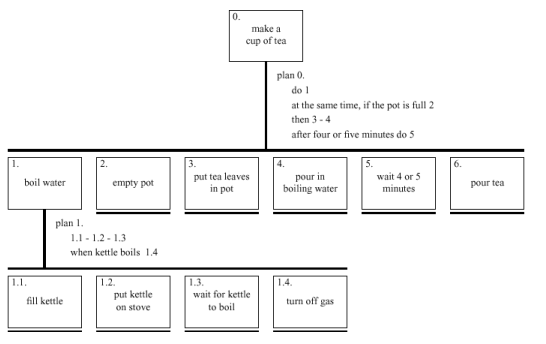Instructional design/Task analysis/Anatomy of an HTA
< Instructional design < Task analysis| ID Homepage | 1. ID task analysis | 2. What is HTA? | 3. Anatomy of an HTA | 4. How HTA Works | 5. Rule of Thumb | 6. Objectives Are Not Subjective |
| Back | Next |
Parts of a whole
Below is an image of a completed HTA (minus the objectives). The most basic HTA has three components:
- The Task = the main goal being observed.
- Subtasks = actions that must be completed before accomplishing the main goal/task.
- Elements = actions that must be completed before accomplishing a subtask.
In rare occasions, an element may be broken down into steps, in which case those steps must be completed in order to complete the element.

This image first appeared in the HCI textbook
An HTA begins with the task to be analyzed. It's a novel idea, I know. In this case, the task is making a cup of tea and is labeled with a 0. The task is then broken down into subtasks labeled 1-6. There may be times that a task to be analyzed will be fairly simple and not require subtasks. Shown here, the first subtask has been broken down into elements, which are labeled 1.1-1.4. These elements must be completed before moving to the next subtask of emptying the pot, which will have a new set of elements.
Click next to continue.
| Back | Next |
| ID Homepage | 1. ID task analysis | 2. What is HTA? | 3. Anatomy of an HTA | 4. How HTA Works | 5. Rule of Thumb | 6. Objectives Are Not Subjective |